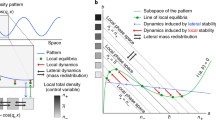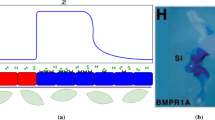Abstract
Reaction–diffusion equations have been widely used to describe biological pattern formation. Nonuniform steady states of reaction–diffusion models correspond to stationary spatial patterns supported by these models. Frequently these steady states are not unique and correspond to various spatial patterns observed in biology. Traditionally, time-marching methods or steady state solvers based on Newton’s method were used to compute such solutions. However, the solutions that these methods converge to highly depend on the initial conditions or guesses. In this paper, we present a systematic method to compute multiple nonuniform steady states for reaction–diffusion models and determine their dependence on model parameters. The method is based on homotopy continuation techniques and involves mesh refinement, which significantly reduces computational cost. The method generates one-parameter steady state bifurcation diagrams that may contain multiple unconnected components, as well as two-parameter solution maps that divide the parameter space into different regions according to the number of steady states. We applied the method to two classic reaction–diffusion models and compared our results with available theoretical analysis in the literature. The first is the Schnakenberg model which has been used to describe biological pattern formation due to diffusion-driven instability. The second is the Gray–Scott model which was proposed in the 1980s to describe autocatalytic glycolysis reactions. In each case, the method uncovers many, if not all, nonuniform steady states and their stabilities.











Similar content being viewed by others
References
Baker RE, Schnell S, Maini PK (2009) Waves and patterning in developmental biology: vertebrate segmentation and feather bud formation as case studies. Int J Dev Biol 53:783
Bates DJ, Hauenstein JD, Sommese AJ (2011) Efficient path tracking methods. Numer Algorithms 58(4):451–459
Bates DJ, Hauenstein JD, Sommese AJ, Wampler II, Charles W (2008) Adaptive multiprecision path tracking. SIAM J Numer Anal 46(2):722–746
Ben-Jacob E, Cohen I, Levine H (2000) Cooperative self-organization of microorganisms. Adv Phys 49(4):395–554
Briggs WL, McCormick SF et al (2000) A multigrid tutorial, 72nd edn. SIAM, University City
Cross M, Hohenberg P (1993) Pattern formation outside of equilibrium. Rev Mod Phys 65(3):851
Ermentrout B (2002) Simulating, analyzing, and animating dynamical systems: a guide to XPPAUT for researchers and students, 14th edn. SIAM, University City
Farrell PE, Birkisson A, Funke SW (2015) Deflation techniques for finding distinct solutions of nonlinear partial differential equations. SIAM J Sci Comput 37(4):A2026–A2045
Freiling G, Yurko V (2001) Inverse Sturm–Liouville problems and their applications. NOVA Science Publishers, New York
Gierer A, Meinhardt H (1972) A theory of biological pattern formation. Kybernetik 12(1):30–39
Gray P, Scott SK (1983) Autocatalytic reactions in the isothermal continuous stirred tank reactor: isolas and other forms of multistability. Chem Eng Sci 38(1):29–43
Gray P, Scott SK (1984) Autocatalytic reactions in the isothermal continuous stirred tank reactor: oscillations and instabilities in the system \({A}+2{B} \rightarrow 3{B};\, {B}\rightarrow {C}\). Chem Eng Sci 39(6):1087–1097
Gray P, Scott SK (1985) Sustained oscillations and other exotic patterns of behavior in isothermal reactions. J Phys Chem 89:22–32
Hao W, Hauenstein J, Hu B, Sommese A (2014) A bootstrapping approach for computing multiple solutions of differential equations. J Comput Appl Math 258:181–190
Hillen T, Painter KJ (2009) A user’s guide to PDE models for chemotaxis. J Math Biol 58(1–2):183–217
Iron D, Wei J, Winter M (2004) Stability analysis of Turing patterns generated by the Schnakenberg model. J Math Biol 49(4):358–390
Jilkine A, Edelstein-Keshet L (2011) A comparison of mathematical models for polarization of single eukaryotic cells in response to guided cues. PLoS Comput Biol 7(4):e1001121
Kaper HG, Wang S, Yari M (2009) Dynamical transitions of turing patterns. Nonlinearity 22(3):601
Kelley CT (1995) Iterative methods for linear and nonlinear equations. Front Appl Math 16:575–601
Koch AJ, Meinhardt H (1994) Biological pattern formation: from basic mechanisms to complex structures. Rev Mod Phys 66(4):1481
Kondo S, Miura T (2010) Reaction–diffusion model as a framework for understanding biological pattern formation. Science 329(5999):1616–1620
Kong Q, Zettl A (1996) Eigenvalues of regular Sturm–Liouville problems. J Differ Equ 131(1):1–19
Lee KJ, McCormick WD, Ouyang Q, Swinney HL (1993) Pattern formation by interacting chemical fronts. Science 261(5118):192–194
Liu C, Fu X, Liu L, Ren X, Chau CKL, Li S, Xiang L, Zeng H, Chen G, Tang L et al (2011) Sequential establishment of stripe patterns in an expanding cell population. Science 334(6053):238–241
Lo W-C, Chen L, Wang M, Nie Q (2012) A robust and efficient method for steady state patterns in reaction–diffusion systems. J Comput Phys 231(15):5062–5077
Maini PK, Woolley TE, Baker RE, Gaffney EA, Lee SS (2012) Turing’s model for biological pattern formation and the robustness problem. Interface Focus 2(4):487–496
Murray JD (2002) Mathematical biology, vol 2. Springer, Berlin
Othmer HG, Painter KJ, Umulis D, Xue C (2009) The intersection of theory and application in elucidating pattern formation in developmental biology. Math Model Nat Phenom 4(4):3–82
Othmer HG, Stevens A (1997) Aggregation, blowup, and collapse: the ABC’s of taxis in reinforced random walks. SIAM J Appl Math 57(4):1044–1081
Painter KJ, Maini PK, Othmer HG (1999) Stripe formation in juvenile Pomacanthus explained by a generalized Turing mechanism with chemotaxis. Proc Natl Acad Sci USA 96(10):5549–5554
Painter KJ, Hillen T (2011) Spatio-temporal chaos in a chemotaxis model. Physica D 240(4–5):363–375
Pearson JE (1993) Complex patterns in a simple system. Science 261(5118):189–07
Robinson M, Luo C, Farrell PE, Erban R, Majumdar A (2017) From molecular to continuum modelling of bistable liquid crystal devices. Liq Cryst 44(14–15):2267–2284
Sommese A, Wampler C (2005) The numerical solution of systems of polynomials arising in engineering and science, vol 99. World Scientific, Singapore
Stoodley P, Sauer K, Davies DG, Costerton JW (2002) Biofilms as complex differentiated communities. Ann Rev Microbiol 56(1):187–209
Sun W, Ward MJ, Russell R (2005) The slow dynamics of two-spike solutions for the Gray–Scott and Gierer–Meinhardt systems: competition and oscillatory instabilities. SIAM J Appl Dyn Syst 4(4):904–953
Thomas JW (2013) Numerical partial differential equations: finite difference methods, vol 22. Springer, Berlin
Turing AM (1952) The chemical basis of morphogenesis. Philos Trans R Soc Lond B 237(641):37–72
Uecker H, Wetzel D, Rademacher J (2014) pde2path-A Matlab package for continuation and bifurcation in 2D elliptic systems. Numer Math Theory Methods Appl 7(1):58–106
Volkening A, Sandstede B (2015) Modelling stripe formation in zebrafish: an agent-based approach. J R Soc Interface 12(112):20150812
Wang Q, Oh JW, Lee H-L, Dhar A, Peng T, Ramos R, Guerrero-Juarez CF, Wang X, Zhao R, Cao X et al (2017) A multi-scale model for hair follicles reveals heterogeneous domains driving rapid spatiotemporal hair growth patterning. eLife 6:e22772
Wei J (2008) Existence and stability of spikes for the Gierer-Meinhardt system. Handb Differ Equ Station Par Differ Equ 5:487–585
Wei J, Winter M (2008) Stationary multiple spots for reaction–diffusion systems. J Math Biol 57(1):53–89
Wilkinson JH (1994) Rounding errors in algebraic processes. Courier Corporation, Chelmsford
Wollkind DJ, Manoranjan VS, Zhang L (1994) Weakly nonlinear stability analyses of prototype reaction–diffusion model equations. SIAM Rev 36(2):176–214
Xu J (1994) A novel two-grid method for semilinear elliptic equations. SIAM J Sci Comput 15(1):231–237
Xue C (2015) Macroscopic equations for bacterial chemotaxis: integration of detailed biochemistry of cell signaling. J Math Biol 70(1–2):1–44
Xue C, Budrene EO, Othmer HG (2011) Radial and spiral stream formation in Proteus mirabilis colonies. PLoS Comput Biol 7(12):12 e1002332
Xue C, Othmer HG (2009) Multiscale models of taxis-driven patterning in bacterial populations. SIAM J Appl Math 70(1):133–167
Xue C, Shtylla B, Brown A (2015) A stochastic multiscale model that explains the segregation of axonal microtubules and neurofilaments in toxic neuropathies. PLoS Comput Biol 11:e1004406
Xue X, Xue C, Tang M (2018) The role of intracellular signaling in the stripe formation in engineered escherichia coli populations. PLoS Comput Biol 14(6):1–23 06
Zhao S, Ovadia J, Liu X, Zhang Y-T, Nie Q (2011) Operator splitting implicit integration factor methods for stiff reaction–diffusion–advection systems. J Comput Phys 230(15):5996–6009
Acknowledgements
This paper is dedicated to Professor Hans G. Othmer’s 75th birthday. The authors would like to thank Kevin Painter, Thomas Hillen, Hans G. Othmer and three anonymous reviewers for helpful comments on the paper. The authors also want to thank Yangyang Wang and Jia Gou for help with XPP.
Funding
Funding was provided by US National Science Foundation (NSF CAREER Award 1553637, NSF DMS 1818769) and American Heart Association (Grant No. 17SDG33660722).
Author information
Authors and Affiliations
Corresponding author
Additional information
Publisher's Note
Springer Nature remains neutral with regard to jurisdictional claims in published maps and institutional affiliations.
Electronic supplementary material
Below is the link to the electronic supplementary material.
Rights and permissions
About this article
Cite this article
Hao, W., Xue, C. Spatial pattern formation in reaction–diffusion models: a computational approach. J. Math. Biol. 80, 521–543 (2020). https://doi.org/10.1007/s00285-019-01462-0
Received:
Revised:
Published:
Issue Date:
DOI: https://doi.org/10.1007/s00285-019-01462-0




